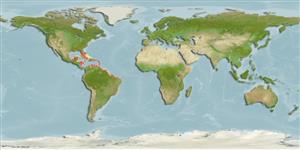Environment: milieu / climate zone / depth range / distribution range
Ecología
marino; salobre asociado a arrecife; oceanodromo; rango de profundidad 0 - 5 m (Ref. 5227). Subtropical; 45°N - 40°S, 98°W - 32°W
Western Atlantic: south Florida (USA), through the Caribbean and along the coasts of Central and South America to Uruguay.
Length at first maturity / Tamaño / Peso / Age
Maturity: Lm 18.9 range ? - ? cm
Max length : 30.0 cm TL macho / no sexado; (Ref. 5217); common length : 20.0 cm SL macho / no sexado; (Ref. 3723)
Body elongate; lower jaw very prolonged; upper jaw short, triangular, and scaly; lower branch of first gill arch with 29 to 38 gill rakers; fins lacking spines; pectoral fins not very long; caudal fin emarginate or slightly forked; anal fin with 15 to 18 rays; back greenish, with 3 narrow, dark, bars; flanks and belly silvery white; fleshy border of lower jaw red; caudal fin light colored with dark tips (Ref. 55763).
An inshore, surface-dwelling species forming sizeable schools, frequently entering estuaries (Ref. 3723). Uncommon over reefs (Ref. 9710). Omnivorous, feeds on algae and other small animals (Ref. 3723). Caught with 'mandinga' nets in Venezuela, often using lights (Ref. 3723). Edible but not really appreciated (Ref. 3723).
Life cycle and mating behavior
Madurez | Reproducción | Puesta | Huevos | Fecundidad | Larva
Robins, C.R. and G.C. Ray, 1986. A field guide to Atlantic coast fishes of North America. Houghton Mifflin Company, Boston, U.S.A. 354 p. (Ref. 7251)
IUCN Red List Status (Ref. 130435: Version 2024-1)
Threat to humans
Reports of ciguatera poisoning (Ref. 30911)
Human uses
Pesquerías: escaso valor comercial; carnada: usually
Herramientas
Special reports
Download XML
Fuentes de Internet
Estimates based on models
Preferred temperature (Ref.
123201): 22.9 - 28.1, mean 27.3 °C (based on 769 cells).
Phylogenetic diversity index (Ref.
82804): PD
50 = 0.5000 [Uniqueness, from 0.5 = low to 2.0 = high].
Bayesian length-weight: a=0.00234 (0.00180 - 0.00305), b=3.09 (3.03 - 3.15), in cm total length, based on LWR estimates for this species (Ref.
93245).
Nivel trófico (Ref.
69278): 2.0 ±0.0 se; based on diet studies.
Generation time: 0.8 ( na - na) years. Estimated as median ln(3)/K based on 1
growth studies.
Resiliencia (Ref.
120179): Alto, población duplicada en un tiempo mínimo inferior a 15 meses (Preliminary K or Fecundity.).
Fishing Vulnerability (Ref.
59153): Low vulnerability (15 of 100).
Nutrients (Ref.
124155): Calcium = 234 [47, 570] mg/100g; Iron = 1.01 [0.31, 3.13] mg/100g; Protein = 18.9 [15.8, 21.3] %; Omega3 = 0.156 [0.056, 0.474] g/100g; Selenium = 13.1 [4.2, 47.4] μg/100g; VitaminA = 47.8 [8.0, 301.1] μg/100g; Zinc = 1.65 [0.61, 4.77] mg/100g (wet weight);
